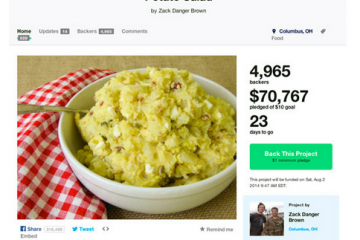10 Unstoppable Steps to Crowd Funding Success!
How many of us have had brilliant “aha moments” or inhaled inspiration, yet nothing ever comes of it because of lack of cash? What if you were given an extra $1k, $5k, $10k (or more?). Guess what, my fellow procrasti-stoners, if socks made of coffee can raise $204,601, or a water bottle that informs you of how much water you take via your iPhone can raise $74,843, then so can you! Two friends and I, even raised $8,169 after sitting around drinking on a couch, lamenting about how cool it would be to create a How-to guide on sharing economy hacks. Within a few short weeks and a Kickstarter Campaign later, “Its a Shareable Life,” was funded and brought to fruition. So why not you?
Crowfunding isn’t just beneficial for the cash, but its very useful for:
a) Testing your market strategy
b) proving there is pre-sale interest
c) generating buzz online
d) inspiring more partners and fans to join the cause!
If you seriously follow these 10 Crowdfunding strategies, and start treating your network as your net worth, you, too, can create a killer Crowdfunding campaign that will inspire an audience to fund your dreams.
STEP 1: Choose a Platform There are hundreds of crowdfunding sites, many specifically aimed at tech, creative projects, charity, social entrepreneurship, sports, science-focused, photojournalism, non-profits, and the like. However, the two most-used platforms are Kickstarter and Indiegogo. With Kickstarter, you have to make your goal to keep the money. With Indiegogo, you have the options to keep the cash whether or not you reach your goal (for a slightly higher fee). With Kickstarer, anyone with an Amazon account can pledge money knowing that if the project does not reach its pre-set goal by the stated deadline, all the money collected is given back to the donors. This “all or nothing” strategy is a powerful motivator because it pushes the creators and their crowdfunders to cross that financial finish line.
STEP 2: Determine Your Budget Figure out the minimum amount of seed money you need to get your project off the ground. Assess your social network and ask yourself, “How much money do we realistically think we can raise?” As unpredictable as hosting a dinner party can be, you are often going to be surprised by unexpected people showing up with bottles of fine wine – as well as those who had RSVP’d immediately and are no-shows.
STEP 3: Create Kick-ass Rewards A reward is a “gift” that you provide to your contributors. Your rewards could be T-shirts, photos, downloads, stickers, the product itself (if you’re creating tangible items like DVD’s, CD’s, books, widgets, etc.), behind the scenes access, or even time with your team. Incentives, incentives, incentives. Unless your crowd is your massive extended family, a rich uncle, or a well-heeled angel investor, you are going to need to appeal to the internet “man on the street”. Some people are driven by altruism, but many more are nudged into action by incentives – so what would these folks need to receive in order to drop $25, $50, or even $500 into your collection bucket?
STEP 4: Create a Compelling Video The video doesn’t have to be perfect, but it represents that you aren’t just any stoner, but a serious one.
► Use the right spokesperson to make the pitch
► Make your pitch in language and tone that fits your campaign
► Make your video both “show” and “tell”
► Explain how you and your team have what it takes
► Express confidence that your project will succeed
► Include “The Ask” – inspire your viewers with a “call to action” now
STEP 5: Plan Your Media Strategy Determine the length of your fundraising campaign – I recommend three weeks, or 30 days, tops. Counterintuitively, shorter Kickstarter campaigns are just as effective as longer ones. According to Kickstarter’s own data, the majority of backers make pledges at the very beginning and at the very end. Remember, though, it takes a lot of constant communication to your network, backers, and possibly even the press throughout a successful campaign, so don’t underestimate the time it will take to get results. How do you make your project stand out? Start by offering your campaign as an opportunity, not a handout. Be confident in your project and your campaign, create valuable rewards to entice contributors, and try to build in a “cool factor” to help generate buzz. Ideally, you want people asking you for the Kool-Aid. Have your pitch explain:
► What your project is
► How your project will benefit society
► Who your team is – add backgrounds and credentials
► How much money is needed – show your budget
► When you need the money – build a sense of urgency, time is ticking
► How you’ll ensure the project will accomplish its goals
► What rewards are given for each contribution level
► Why contributors will become “heroes” for “doing the right thing”
Contact Bloggers like Stuie and have them ready to write for you– especially during the middle and ending periods of your campaign. Bloggers get this editor-in-cheap, get pitched a lot, so find as many as you can through mutual friends on Facebook. Write them cordial, personal letters asking for their help and suggest ways that this would be mutually beneficial for their readers. You want your project to generate buzz and get legs to reach a broader audience and more potential backers. Make it easy for bloggers to help you by providing them with all the content, links, graphics, and pictures they need to get onboard.
STEP 7: Leverage Your Social Networks If you were not a social media butterfly before, you are going to have to find your wings now. Email is the #1 most effective way to crowdfund; then comes Facebook, Twitter, and blogging. Uber-creative types can also try guerrilla marketing techniques, like tear-off sheets on street kiosks, starting rumors, and hiring the Goodyear blimp. In any case, try to cover all the bases in your campaign’s ball- park. Those who post updates every five days or less will raise four times more money than those who post every 20 days or more, according to Indiegogo’s Slava Rubin. Heavy emailing efforts at the start and the end of the fundraising period will be your keys to success. Tip: Seek relevant online media postings about the project and email progress updates to your network. Make sure the information is timely and important, so people don’t feel spammed. Tip: Always make the emails personal, especially to family or friends. Although the bulk of your email will be cut and pasted, start off with an extra sentence or two to say something personal. Facebook Fanatically
- ► Get your Facebook network talking about your campaign
- ► Ask interesting questions that are easy to answer
- ► Post once a day (minimum) during your campaign
- ► Ask people to “Share” or “Like” your campaign
- ► Be personal and personable
- ► Release short video updates
- ► Don’t forget a call to action!
- ► Relate current events to your campaign
- ► Use humor – share relevant jokes or Youtube videos
- ► Ask your audience to post questions, pictures, or stories about you
Tip: Not many know this, but Facebook has a “Happiness Index” that shows a consistent spike in activity of 10% on Fridays. So take advantage of this by reaching out then! If you end your campaign on a Friday – ideally a pay day – people will be feeling grateful for the weekend and may be in a more giving mood. Twat Twittastically This concise, micro-blogging, far-reaching network is perfect to remind folks you still need their pledges. Too many cooks may spoil the soup, but too many Tweets do not spoil the campaign. Au contraire, mon frere. Ask for re-tweets and thank your loyal re-tweeters. Use popular hashtags # time and again, and call your Twitter fan base to action! Get Bloggers Bloggin’ Do your homework and find bloggers sympathetic to your cause. Contact neighborhood and city-wide hand-out publica- tions. If you have a contact at a major newspaper, now is the time to call in those markers, if you have any. Search influential websites for topics that overlap your subject area. It’s been said that there’s no such thing as bad publicity, so get going.
STEP 8: Work Your Campaign It’s not exaggerating to say this should become your full-time job. If you want to reach your financial goal you are going to have to schedule the time, so roll up your sleeves and do what needs to be done. It’s not sufficient to set up the platform, the budget, the rewards, the video, and just wait for the money to roll in. You need to press the electronic flesh out there, put in the time to contact people, respond to inquiries, and then contact even more people. Pay attention to what is working, and especially to what is lacking. Your campaign is like a living organism. Ignore it at your peril.
STEP 9: Give Credit Where Credit Is Due People love to be acknowledged, whether it’s in the film credits, on your website, tagged in a Facebook post, mentioned in a blog, or even directly emailed (especially those people who contribute larger amounts). Let people know how much their help and support have meant to you. Of all your tasks enroute to crowdfunding success, this is one of the easiest to do and the easiest to forget. In conclusion, we are no longer limited by what opportunities are immediately in front of us – at any point any one of us can take on a previously unimaginable project, reimagine an entirely new business, or develop a prototype of an innovative invention. So, take that great idea off your “shoulda, woulda, coulda” pile and start putting up a crowdfunding profile. The world is your oyster – so get out of your shell and make something!
Step 10: Once you can fill out the worksheet below, you will have all tools to begin your successful campaign: 1. Project Name 2. Funding Goal 3. Campaign Duration 4. Choose Platform: 5. Why should this project exist? (Think what message are you offering the world? What gap are you filling? 6. List at least 3-5 potential rewards you could offer (be creative) but make sure you can deliver. 7. Define Your narrative:Explanation (what) , Meaning (why), and Story (how) 8. Pitch Video Ideas (Think: Humor, drama, authenticity) 9. List some existing blogs/orgs that could help you spread the word: 10. What specific updates could you release through your campaign (Think video/audio/written).
But seriously, if this dude in Columbus, Ohio, by the name Zack (Danger) Brown can raise money to make potato salad, then anything is possible.
If you found this how-to Crowdfunding article helpful, then get more life-altering Sharing Economy tips, by checking out www.ItsaShareableLife.com
. 
Chelsea Rustrum, Gabriel Stempinski, Alexandra Liss










